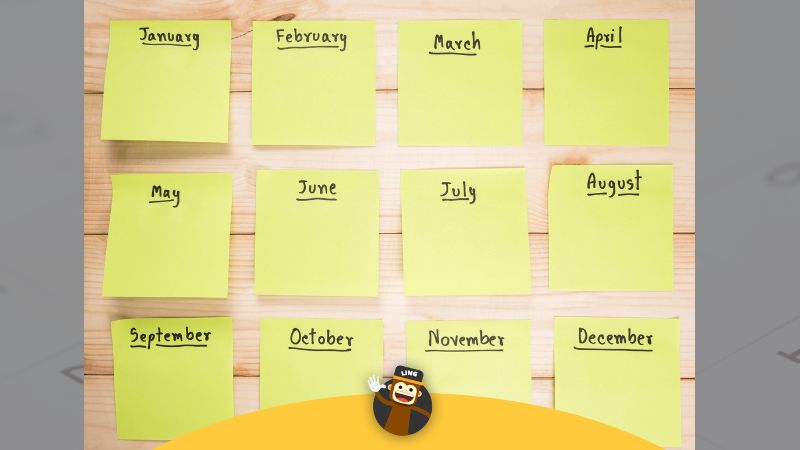Visiting or moving to a new country can be daunting. Denmark is a fabulous country and while over 85% of the population can speak some English, you’ll still want to know how to read and talk about dates and time in Danish.
The Danish language isn’t necessarily difficult to learn. In fact, as you’ll see, many of the names for days of the week or months kind of sound quite similar to their English counterparts.
There are some slight differences between how the Danish tell time and this is largely reflected in how they divide up their day, which we’ll investigate in more detail below. Otherwise, things are relatively the same including the Danish calendar. They use the Gregorian calendar which means they start and end their year at the same time as most of the world.
Are you ready for your first Danish language lesson about time? Let’s go!
What Are The Days Of The Week In Danish?

In Europe and Denmark, the first day of the week is actually Monday, not Sunday. Also, note that the days of the week in Danish don’t begin with a lowercase letter.
Here are the days of the week (ugens dage):
| English | Danish | Pronunciation |
| Monday | mandag | |
| Tuesday | tirsdag | |
| Wednesday | onsdag | |
| Thursday | torsdag | |
| Friday | fredag | |
| Saturday | lørdag | |
| Sunday | søndag |
Here is how you say weekend, which is the same as in English!
If you’d like to specify which day of the week you do something this is what you would say:
| English | Danish | Pronunciation |
| on Monday | på mandag | |
| on Tuesday | på tirsdag | |
| on Wednesday | på onsdag | |
| on Thursday | på torsdag | |
| on Friday | på fredag | |
| on Saturday | på lørdag | |
| on Sunday | på søndag |
How To Say The Months Of The Year In Danish

Many of the Danish words for months are very similar in sound as the months in English. Some are even the exact same! You’ll also notice that they do capitalize their months.
These are the months of the year (måneder af året):
| English | Danish | Pronunciation |
| January | Januar | |
| February | Februar | |
| March | Marts | |
| April | April | |
| May | Mai | |
| June | Juni | |
| July | Juli | |
| August | August | |
| September | September | |
| October | Oktober | |
| November | November | |
| December | December |
How To Say Seasons In Danish

Denmark’s climate is a coastal climate. This means the nation has damp, cool winters and cool, rainy summers. Temperatures throughout the year vary from about two degrees Celsius in the winter time to about 16 degrees in the summertime.
How Do They Write The Date In Denmark?

In Danish, like in many other European languages, the written date format is dd.mm.yyyy.
This means that when you write or say the date in Denmark, you must make a slight adjustment. For example:
- February 28th would be 28. februar.2022.
- July 10 would be 10. juli.2022.
To write the full date like Monday, July 10, 2019, in Denmark it would be written as such:
- mandag, den 10. juli 2019
or - mandag, d. 10. juli 2019
To really help you sound like a native you’ll need to learn Danish numbers right here! This will make saying the date in Danish so much better.
Do the Danish Use the 12-Hour Clock or 24-Hour Clock?

Well, in Denmark they use the 24-hour clock which is sometimes referred to as military time. That means the Danes do not use AM and PM. Just in case you’re not familiar with the 24-hour clock, here it is:
| 12 Hour Clock | 24 Hour Clock |
| 12:00 AM | 0:00 |
| 1:00 AM | 1:00 |
| 2:00 AM | 2:00 |
| 3:00 AM | 3:00 |
| 4:00 AM | 4:00 |
| 5:00 AM | 5:00 |
| 6:00 AM | 6:00 |
| 7:00 AM | 7:00 |
| 8:00 AM | 8:00 |
| 9:00 AM | 9:00 |
| 10:00 AM | 10:00 |
| 11:00 AM | 11:00 |
| 12:00 PM | 12:00 |
| 1:00 PM | 13:00 |
| 2:00 PM | 14:00 |
| 3:00 PM | 15:00 |
| 4:00 PM | 16:00 |
| 5:00 PM | 17:00 |
| 6:00 PM | 18:00 |
| 7:00 PM | 19:00 |
| 8:00 PM | 20:00 |
| 9:00 PM | 21:00 |
| 10:00 PM | 22:00 |
| 11:00 PM | 23:00 |
How To Tell Time In Denmark
The Danish don’t use AM or PM, so how do they differentiate times of day in Denmark?
With a.m. and p.m. not being used, the Danish use adverbs to indicate times of the day and they are:
- morning – morgen
- forenoon – formiddag
- noon – middag
- afternoon – eftermiddag
- evening – aften
- night – nat
- midnight – midnat
Each designation lasts for a very specific period of time each day and you need to be aware of this because it will give you away in conversation as a non-native speaker!
- morgen – 6am to 9am (0600-0900)
- formidddag – 9am to 12 noon (0900 – 1200)
- frokost – 12 noon to 1pm (1200 – 1300)
- eftermiddag – 12 noon to 6pm (1200 – 1800)
- aften – 6pm to 12 midnight (1800 – 2400)
- nat – midnight to 6 am (2400 – 0600 )
For instance, if you were to say “Good morning! (god morgen!) at 10 am, you would be looked at funny because morning is finished!
When you’re speaking about time in Denmark you would simply add the adverb of time after the hour to indicate whether you mean AM or PM. For example:
- 9am – 9 morgen (9 in the morning)
- 12pm – 12 frokost (12 midday)
- 4pm – 4 eftermiddag (4 in the afternoon)
- 9pm – 9 aften (9 in the evening)
However, watch out because there are exceptions to this such as on timetables for buses, trains, and movies you would say the time is military time.
How To Understand Half-past, Quarter To, And Quarter Past In Danish
Half Past
So this is where it gets tricky. Let’s begin with how to say 1:30. In English, we would say half-past one, however, in Danish, half hours are relative to the next hour. Therefore, 1:30 would be said as “half 2“. A bit confusing right? Let’s take a look at a few examples:
- 15:30 would be “half 4”
- 12:30 would be “half 1”
- 9:30 would be “half 10”
Telling Time in Minutes
If you thought that was confusing just wait for this! The general rule for expressing time in minutes from minutes 1-29 is to simply say, for example, 12 minutes past 2. Okay, that’s easy enough. It’s 02:12. But, the closer you get to the half-hour, the Danes tend to express time as how many minutes to the next half hour.
For instance, if it’s 4.23 pm, you would say “7 minutes to half 5”. I’m shaking my head, you’re shaking your head, but this is just how they do it! Here are a few more examples::
- 16:28 – “2 minutes to half 5“
- 22:17 – “13 minutes to half 11″
- 13:21 – “9 minutes to half 2“
Quarter Hours
Quarter hours are thankfully expressed just like they are in English. Phew!
For example:
- 6:15 (kvart over 6) would be quarter past six
- 19:15 (kvart over 7) would be quarter past seven
- 6:45 (kvart i 7) would be quarter to seven
- 19:45 (kvart i 8) would be a quarter to eight
Talking About Time In Danish

How To Ask and Answer Questions About Time in Denmark
What time is it? Hvad er klokken?
- … eight o’clock. … klokken er otte
- … half past eight. …tredive minutter over otte
- … quarter past eight. … kvart over otte
- … quarter to eight. … kvarter i otte
What are you doing this weekend? – Hvad skal du i weekenden?
I am planning to stay at home. – Jeg planlægger at blive hjemme
This week I am busy. – Jeg har optaget denne uge
I am free tomorrow. – Jeg er ledig i morgen
Is this date OK with you? – Er denne dato okay med dig?
When is the best time that suits you? – Hvornår er det bedste tidspunkt, der passer dig?
Talking About Time In Danish
These are some important phrases and words related to the time that you’ll find useful to know in Danish so you can best express yourself on your journey or time in Denmark.
Adverbs of Time
Other Important Vocabulary Of Time And Dates In Danish To Know
Here are the common words related to time in Danish to use when discussing timeframes:
| English | Danish | Pronunciation |
| day | dag | |
| days | dage | |
| hour | time | |
| hours | timer | |
| minute | minut | |
| minutes | minutter | |
| month | måned | |
| months | måneder | |
| second | sekund | |
| seconds | sekunder | |
| week | uge | |
| weeks | uger | |
| year | år | |
| years | flere år |
That’s All For Dates And Time In Danish!
That doesn’t mean you stop learning though! Knowing date and time vocabulary is important to help you get around Denmark, but imagine how much more confident you’d feel communicating in Denmark if you knew just a little bit more Danish?!

That’s where Ling comes in. Ling is actually the name of our helpful monkey mascot who will guide you through the process to learn Danish or any one of the 60 other languages that we have to offer.
Our fun and the engaging app will have you reading, writing, and speaking in only 10 – 15 minutes a day. Take a moment to check us out on the Play Store or the Apple Store and see what over 10 million users are raving about!















